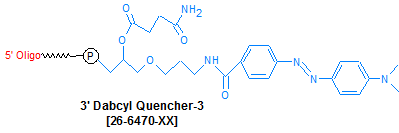
Modification : Dabcyl-3'
Catalog Reference Number
Category
Modification Code
5 Prime
3 Prime
Internal
Molecular Weight (mw)
Extinction Coeficient (ec)
Technical Info (pdf)
Absorbance MAX
Emission MAX
Absorbance EC
| Catalog No | Scale | Price |
| 26-6470-05 | 50 nmol | $159.00 |
| 26-6470-02 | 200 nmol | $159.00 |
| 26-6470-01 | 1 umol | $207.00 |
| 26-6470-03 | 2 umol | $305.00 |
| 26-6470-06 | 5 umol | $931.50 |
| 26-6470-10 | 10 umol | $1,160.00 |
| 26-6470-15 | 15 umol | $1,315.00 |
Dabcyl-3' is classified as a dark quencher (a non-fluorescent chromophore), and is typically used to label a Fluorescence Resonance Energy Transfer (FRET) DNA oligonucleotide probe with a quencher moiety at the 3'-end. Such probes are primarily used in nucleic acid assays, but also find a place in nucleic acid structural studies (1). Examples include TaqMan probes (2), Scorpion primers (3), and Molecular Beacons (4).
Dabcyl-3' has an absorbance maximum of 479 nm, and an effective absorbance range of 346-489 nm. It is the preferred quencher for pairing with fluorescent dyes that emit in the blue to green part of the visible range (442-506 nm).
The emission spectra of this set of dyes sufficiently overlaps the absorbance spectrum of Dabcyl to allow the latter to quench the fluorescence of the former with a high degree of efficiency.
The advantages of using a dark quencher in a FRET probe are (a) low background fluorescence (and thus better signal-to-noise ratio), (b) higher dynamic range, (c) amenability to multiplex assays (due to a dark quencher having no secondary fluorescence), and (d) ease of synthesis of FRET probes with a dark quencher (due to dark quenchers being resistant to degradation during the oligo deprotection step) (5).
<
Click here for list of quenchers.
Click here for a list of fluorophores.
|
Quencher Spectral Data
|
|
Quencher
|
Absorption Max, nm
|
Quenching Range, nm
|
| Dabcyl |
453 |
380-530 |
| BHQ-0 |
495 |
430-520 |
| BHQ1 |
534 |
480-580 |
| BHQ2 |
579 |
550-650 |
| BHQ3 |
672 |
620-730 |
| BBQ-650 |
650 |
550-750 |
|
Click here for complete list of quenchers and details
|
**Black Hole Quencher License Agreement
Black Hole Quencher License Agreement.
"Black Hole Quencher®, BHQ®, CAL Fluor® and Quasar® are registered trademarks of
Biosearch Technologies, Inc., Petaluma, California.
The BHQ, CAL Fluor and Quasar dye technologies are protected by U.S. and world-wide patents either issued or in application. Compounds
incorporating these dyes are made and sold under agreement with Biosearch Technologies, Inc. for end-user's non-commercial research and development use only.
Their use in commercial applications is encouraged but requires a separate Commercial Use License granted by Biosearch Technologies, Inc."
|
References
1. Didenko, V.V. DNA Probes Using Fluorescence Resonance Energy Transfer (FRET): Designs and Applications. Biotechniques (2001), 31: 1106-1121.
2. Livak, K.J., Flood, S.J.A., Marmaro, J., Giusti, W., Deetz, K. Oligonucleotides with fluorescent dyes at opposite ends provide a quenched probe system useful for detecting PCR product and nucleic acid hybridization.PCR Methods Appl. (1995), 4: 1-6.
3. Thelwell, N., Millington, S., Solinas, A., Booth, J., Brown, T. Mode of action and application of Scorpion primers to mutation detection. Nucleic Acids Res. (2000), 28: 3752-3761.
4. Tyagi, S., Kramer, F.R. Molecular beacons: probes that fluoresce upon hybridization. Nat. Biotechnol. (1996), 14: 303-308.
5. Yeung, A.T., Holloway, B.P., Adams, P.S., Shipley, G.L. Evaluation of dual-labeled fluorescent DNA probe purity versus performance in real-time PCR. Biotechniques. (2004), 36: 266-270, 272, 274-275.
- Dabcyl Quencher-3'
